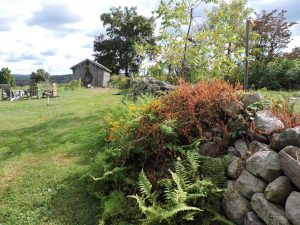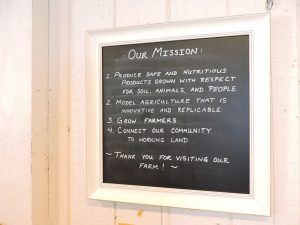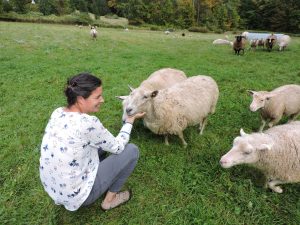
Forty years ago, when CFE/Save the Sound was started, the Connecticut landscape was a beautiful patchwork of family farms. Over time, that has eroded away to just a few surviving remnants of our agricultural past.
Why? There are many reasons, but among them is climate change, which is creating unpredictable and extreme weather patterns that jeopardize soil integrity and rain patterns, and thereby our food system. Unpredictable weather patterns are changing the way farmers decide what crops to plant and inhibiting their ability to provide a range of crops for their community and for their soil.

Right now, farming and land use account for 25 percent of global greenhouse gas emissions, and that means they can be part of the solution. Since farming can be both a victim and a cause of climate change, some farmers, including Dina Brewster, see it as an “incredible opportunity to include working land” in our climate change adaptation and reversal strategies. How? Carbon sequestration in soil, among other things.
Brewster, CFE/Save the Sound board member and executive director of the Northeast Organic Farming Association, envisions a future where the farming community is a resource in the climate change adaption conversation. She manages 40 acres of The Hickories, an organic farm in Ridgefield Connecticut. Brewster gave up teaching fifteen years ago to be a driving force behind the movement utilizing organic farming as a means to combat climate change through concrete, quantifiable action. 
“Seeking resilience in the face of climate change is now what gets me up in the morning and tucks my kids in at night,” said Brewster.
Climate change is taking a toll on farmers, but Brewster is growing tired of narratives that paint farmers as its casualties. Instead she wants people turning to farmers as leaders, looking for ways to turn land use from the problem to part of the solution.
“The amount of awareness building that organizations have done has been so effective and so fantastic, but I am someone who picks up a bucket and starts bailing,” added Brewster. “I’m ready to see concrete adaption strategies implemented in the state.”
The greatest of these strategies is carbon sequestration in soil, which prevents carbon from entering our atmosphere. Brewster incorporates all typical organic farming methods to maintain her soil as a carbon sink, including cover cropping, re-mineralization, and amending fields with compost. In terms of reversing climate change, a 1% increase in soil organic matter across one acre can sequester over 15 tons of CO2.
There is not just one solution for reversing and adapting to climate change, and Brewster has made it her mission to find and implement as many as possible. She has turned to both traditional and modern organic farming methods to transform her farm into its own self-sustaining ecosystem. She has solar panels on her roof that supply electricity to the farm’s refrigerators, pigs that clear her land and remove her compost, and a new seeding crop project that promotes biodiversity with Connecticut’s native species and increases the abundance of crucial pollinators like bees and butterflies. As Brewster says, “when the insects go, we go.”

The native seeding crop project is a new initiative that Brewster has become involved with to increase the availability of Connecticut native species for local gardens. However, it goes much deeper than that. These plants are not just Connecticut natives, they are native to the specific regions of Connecticut in which they are found. Brewster is growing seeds of plants that have DNA for specific eco-regions to ensure that every plant has evolved exactly for the climate and terrain they live on. This gives them an incredible advantage when it comes to surviving in our changing climate.
“We have to recognize the intimate link we have with the species around us and the dependency we have on them,” said Brewster. “Those plants are our best hope in terms of resilience to this Connecticut climate in the next 100 years.”
At the Hickories, Brewster does not just foster an environment that is sustainable for the land, but one that is also sustainable for the farmers. The average age of the Connecticut farmer is between 57 and 58. As a former teacher, Brewster feels strongly about raising the next generation of farmers by fostering a love of the land and work.
“Sometimes I think people forget that the most important thing to sustain on a sustainable farm is the farmer,” said Brewster.
She is bringing the agriculture community to the table with the scientific and conservation communities to create sustainable solutions that work.
“Instead of saying ‘here are 20 things you can’t do, here are ways in which living an environmentally conscious life is going to be harder,’ instead we say, ‘sit down, have a beautiful view, eat some food, laugh and play outdoors,’” explained Brewster. “Our movement to bring people back to farming is about that beautiful solution.”
